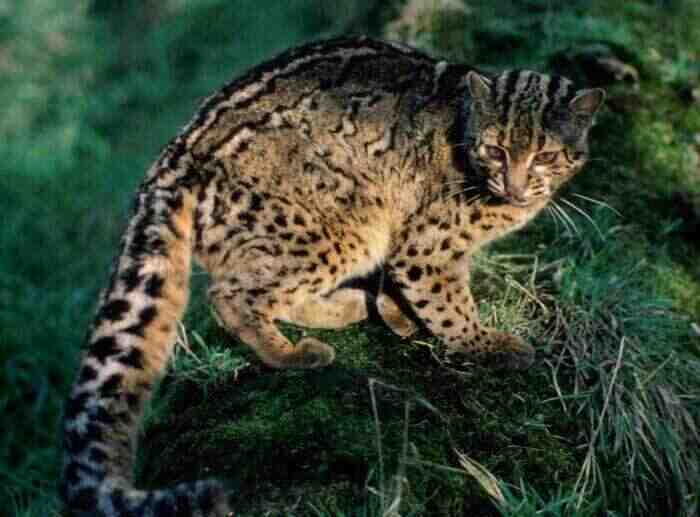Pardofelis marmorata charltoni
IUCN
LCBasic Information
Scientific classification
- name:Pardofelis marmorata charltoni
- Scientific Name:Pardofelis marmorata charltoni,Nepalese Marbled Cat, stone cat, spotted cat, grass leopard, clouded leopard, Nepalese cat
- Outline:Carnivora
- Family:Feliformes Felidae Felinae Felis
Vital signs
- length:40-60cm
- Weight:3-5.5kg
- lifetime:About 12 years
Feature
Professional killer of squirrels
Distribution and Habitat
Origin: Nepal and India, only found in Yunnan and Tibet in China.
It mainly inhabits lowland tropical forests and is also found in newly logged forests. In the eastern foothills of the Himalayas, it inhabits moist deciduous and semi-evergreen forests at an altitude of 1500-3000 meters.
Appearance
The back of the body is brownish yellow, brownish gray or ocher brown. Ventral surface grayish yellow. There are two intermittent lines of black lines from the nape of the neck along the midline. There are small black-edged patches arranged diagonally on the side of the body. Sometimes they blur or merge, forming unique body patterns of yellow and black. Looks like marble spots. The head, limbs and tail are all yellow with black spots scattered on them. The ears are small and round, with black backs and a small white spot. The pupils are large, light brown, and round when contracted.
The skull is tall, the nasal bones are short, and the nasal branch of the premaxilla is not expanded. The zygomatic arch is wide, and the orbital process of the zygomatic bone is slender and connects upward with the postorbital process to form the orbital ring. The interorbital area is narrow. The bitemporal crest is arcuate and merges into a short sagittal crest only in older individuals. Interwing for
Details
The Nepalese Marbled Cat is a subspecies of the marble cat. It is slightly larger than a domestic cat, with a tail that is nearly as long as its body and very large feet. It is more like a panther than a cat.

Clouded cats are genetically between "big cats" (such as tigers, leopards, snow leopards, lions, etc.) and "small cats" (such as wild cats, ocelots, jungle cats, etc.). They share some genetic characteristics with tigers, and because of their ancient origins, scientists believe that they are at the watershed of "size" differentiation in the evolution of cats.
As a forest dweller, clouded leopards spend more time in trees, so they are very good at climbing. Their long tails help them balance on branches, allowing them to live between branches on steep riverbanks. Interestingly, clouded leopards have a typical posture of arching their backs. When they squat or lie down, they often retract their heads slightly and arch their backs, looking alert and cute.
Because the fighting power is far different, and clouded leopards can also move flexibly in trees, squirrels are basically in danger of death when they encounter clouded leopards. Moreover, the size of squirrels is just suitable for clouded leopards to eat, so for the squirrel family, the existence of clouded leopards is like a little devil in the forest, a professional killer of squirrels.
On October 7 and November 11, 2014, cats were photographed twice in the Gaoligongshan National Nature Reserve in Yunnan, China, and were identified as clouded leopards by many experts. It is reported that this is the first batch of wild images of clouded leopards in Yunnan, and it is also the return of clouded leopards in Yunnan more than 30 years after they were discovered in December 1984. In February 2016, infrared camera photos provided by the Tengchong Branch of the Gaoligongshan National Nature Reserve in Yunnan (taken on December 16, 2015) showed that a clouded leopard appeared in Dahelinggan, Datang District. In September 2020, the Baoshan Nature Reserve in Yunnan used infrared cameras to capture images of clouded leopards in action. Clouded leopards are relatively rare compared to other cats, but the encounter rate in Cambodia is higher than in other areas, and 13 images of wild clouded leopards were captured.
In Yunnan Province, four nature reserves have been established in the clouded cat distribution area (Jingdong Wuliangshan Nature Reserve, Xinping Ailaoshan Nature Reserve, Dali Cangshan Nature Reserve, Lijiang Wanglongshan Nature Reserve), with a total area of 126,000 square meters. Clouded cats are expected to be protected in such reserves.
Listed in the "China Species Red List": Critically Endangered (CR).
Listed in Appendix I of the Convention on International Trade in Endangered Species of Wild Fauna and Flora (CITES).
Listed in the IUCN Red List of Threatened Species: Vulnerable (VU), assessed in 2008.
Listed in the List of Terrestrial Wildlife with Important Economic and Scientific Research Values Protected by the State, issued by the State Forestry Administration of China on August 1, 2000.
Listed in the second level of the List of Wildlife under Key National Protection in China.
Protect wildlife and eliminate game.
Maintaining ecological balance is everyone's responsibility!








